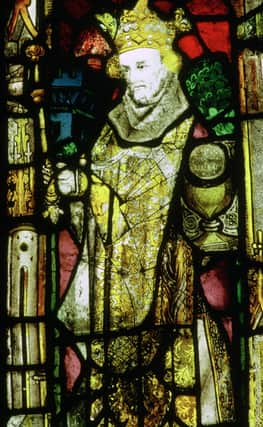Canon Hilary Barber:


By Canon Hilary Barber, Vicar of Halifax Minster
We believe that he was a soldier living in Palestine at the beginning of the fourth century, and martyred at Lydda in about the year 304 at the beginning of the Diocletian persecution and he became known throughout the East as ‘The Great Martyr’.
The story of him slaying the dragon is probably a myth and confused with St Michael or mistaken identity for Perseus slaying of the sea monster.
Advertisement
Hide AdAdvertisement
Hide AdGeorge replaced Edward the Confessor as Patron Saint of England following the Crusades, when returning soldiers brought back a renewed cult of St George. Edward III made St George patron of the Order of the Garter, which seems to have finally confirmed his position.
I have to confess that I would have preferred us to have stayed with Edward the Confessor, who I regard as a far more worthy recipient as Patron of England.
Edward was born in 1002, the son of the English King Ethelred and his Norman wife Emma.
Living in exile during the Danish supremacy, he was invited back to England in 1042 to become king, and was heartily welcomed as a descendent of the old royal line.
Advertisement
Hide AdAdvertisement
Hide AdHowever, his reign was a balancing act between the influences of stronger characters at his court or overseas, sustained by Edward’s diplomacy and determination.
Edward’s reputation for sanctity was built on his personal, more than his political, qualities.
He was concerned to maintain peace and justice in his realm, to avoid foreign wars, and to put his faith into practise.
He was generous to the poor, hospitable to strangers, but no mere pietist.
Advertisement
Hide AdAdvertisement
Hide AdHaving vowed as a young man to go on pilgrimage to Rome should his family fortunes ever be restored, he later felt it irresponsible to leave his kingdom, and was permitted instead to found or endow a monastery on Thorney Island, by the river Thames, thus beginning to royal patronage of Westminster Abbey.
He died on January 5, 1066 and his remains were translated to the Abbey on October 13 in 1162.
Many public buildings and churches fly the St George’s Flag at this time of the year.
Sadly, some extreme political groups have tried to use it as a symbol of nationalism, but instead of using it to unite the nation, its being used to divide the nation.
Advertisement
Hide AdAdvertisement
Hide AdAs a nation we continue to see the realities of Brexit, and work out where our future might be as a nation and within the world.
Our influence is certainly waning fast across the world, with our armed forces smaller now than it has been for hundreds of years.
Our exit from the European Union means with have lost any economic influence we had before, and only this week it became clear amongst many of the things we have lost include access to pharmacy, with a significant shortage of drugs available to the NHS.
I’m left utterly confused as to what Brexit has given us, and I’m struggling to see anything positive that has improved my life and that of my neighbours?
I am however, happy to follow Edward the Confessor’s example, that we should look to maintain peace and justice, avoid foreign ward, and to put our faith – what ever that maybe, into practise.